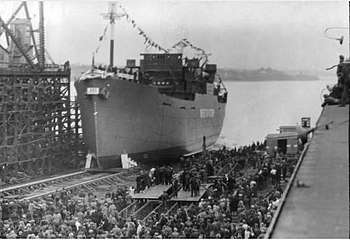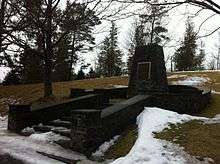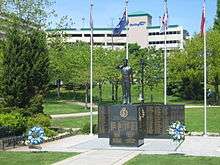Park ship
Park ships were merchant steamships constructed for Canada’s Merchant Navy during the Second World War. Park ships and Fort ships (built in Canada for operation by the British) were the Canadian equivalent of the American Liberty ships. All three shared a similar design by J.L. Thompson and Sons of Sunderland, England. Fort ships had a triple expansion steam engine and a single screw propellor. Fort ships were ships transferred to the British Government and the Park ships were those employed by the Canadian Government, both had the similar design. Park ships were named after local and National Parks of Canada. A few Park ships were launched as "Camp ships", named after Canada military camps, but were quickly renamed after Parks. Jasper Park was first Park ship lost to enemy attack, in the Indian Ocean after a torpedo attack from U-177 in the Indian Ocean, South of Durban, South Africa.[2][3] [4][5]
 Launch of SS Ashby Park at the Pictou Shipyard in 1944 | |
| History | |
|---|---|
| General characteristics Park Ship | |
| Tonnage: | |
| Length: | 315 ft 5 in (96.14 m) |
| Beam: | 46 ft 5 in (14.15 m) |
| Depth: | 22 ft 9 in (6.93 m) |
| Installed power: | Triple expansion steam engine |
| Propulsion: | Screw propellor |
| Crew: | 34, plus 4 DEMS gunners |
| Armament: |
|
Park Steamship Company
The Allied merchant fleet suffered significant losses in the early years of the Battle of the Atlantic as a result of U-boat attacks. The Park Steamship Company was created by the Canadian government on April 8, 1942 to oversee construction of a merchant fleet to help replace the lost vessels and to administer the movement of materiel. This was part of a coordinated Allied effort that saw the construction of British, American and Canadian merchant ships using a common class of vessel known as the North Sands class (named after a beach near the J. L Thompson yard on the River Wear).[6][7]
Vessels
Over the next three years, the company ordered approximately 160 bulk cargo ships and 20 tankers that would all fly the Canadian flag. Ships at 10,000 tons deadweight were known as Park class. Smaller vessels, at a nominal 4,700 tons, were at first designated Grey class but were later called Park ships as well and were commonly known as the 4700 tonner Park ships. All the Park ships were powered by coal driven steam engines. All but two vessels launched were named for federal, provincial or municipal parks in Canada. Some were armed with bow guns and anti-torpedo nets. Two of the Park ships were lost to natural hazards and four were lost due to enemy action. One, Avondale Park, built at the Pictou Shipyard in Pictou, Nova Scotia was one of two Allied ships destroyed by enemy action in the North Sea in the last hour of the war in Europe on May 7, 1945.[8][9][10][11]
At the same time, Canada produced 90 additional vessels for the American government which were turned over to the British Merchant Navy under a lend-lease agreement.[12] Built to the same design but designed to burn oil instead of coal, these vessels were known as Fort ships, and they took their names from forts. Notable ships of this type included Fort Cataraqui, Fort Rosalie, and Fort Charlotte. Like many of the Fort ships, Fort Charlotte was launched as a Park. The hull of the Park ships were riveted, not welded.
After the war, by 1948, all the fort ships had been sold to private companies all around the world. The new owners gave the ships new names.


Crew
Park ships were armed. There were merchant seamen gunners. Also many British and Canadian merchantmen carried volunteer naval gunners called Defensively equipped merchant ship or DEMS gunners. The American ships carried Naval Armed Guard gunners. Merchant seamen crewed the merchant ships of the British Merchant Navy which kept the United Kingdom supplied with raw materials, arms, ammunition, fuel, food and all of the necessities of a nation at war throughout World War II literally enabling the country to defend itself. In doing this they sustained a considerably greater casualty rate than almost every branch of the armed services and suffered great hardship. Seamen were aged from fourteen through to their late seventies.[13] The lost are remembered in The Royal Canadian Naval Ships Memorial Monument in Spencer Smith Park in Burlington, Ontario.[14]
Shipyards

The shipbuilding program was not easy to implement as Canada had only four operational shipyards with nine berths in 1940. By 1943, there were six additional shipyards and a total of 38 berths. These were all private shipyards located across Canada - on the East Coast at Pictou and Saint John, in Montreal, Sorel and Lauzon on the St. Lawrence River, at Collingwood on Georgian Bay, and Victoria, Vancouver and Prince Rupert on the Pacific Coast. Only the yards at Montreal, Saint John, Victoria and Collingwood had existed before the war. By 1945, there were 57,000 men and women employed in building or repairing merchant ships in Canada and several thousand more were employed building ships for the Royal Canadian Navy.[15]
The table shows the name of the shipyard and city, and the number of vessels launched by each yard.[12] Eventually thousands of Canadians and British would serve aboard these Canadian Merchant Navy ships.[16]
| Shipyard | City | Vessels Launched |
|---|---|---|
| Burrard Dry Dock Co. Ltd. | North Vancouver (BC) | 24 |
| North Van Ship Repair Ltd. | North Vancouver (BC) | 18 |
| Prince Rupert Dry Dock & Shipyard | Prince Rupert (BC) | 6 |
| Victoria Machinery Depot Co. Ltd. | Victoria (BC) | 11 |
| West Coast Shipbuilders Ltd. | Vancouver (BC) | 24 |
| Canadian Vickers Ltd. | Montreal (Quebec) | 1 |
| Davie Shipbuilding & Repair Co Ltd. | Lauzon (Quebec) | 16 |
| Foundation Maritime Pictou Shipyard | Pictou (NS) | 24[17] |
| Marine Industries Limited | Sorel (Quebec) | 18 |
| Morton Engineering & Dry Dock Co. Ltd. | (Quebec) | 4 |
| Saint John Dry Dock Co. Ltd. | Saint John (NB) | 8 |
| United Shipyards Ltd. | Montreal (Quebec) | 25 |
| Collingwood Shipyards Ltd. | Collingwood (ON) | 3 |
| Total | 182 | |
Ships in Class
Park-type Cargo Ships
- Wascana Park
- Strathcona Park
- Beaton Park
- Sapperton Park
- Mewata Park
- Louisbourg Park
- Tipperary Park
- Bowness Park
- Westend Park
- Dunlop Park
- Tobiatic Park
- Kootenay Park
- Mohawk Park
- Seacliff Park
- Coronation Park
- Fairmount Park
- Cromwell Park
- Princeton Park
- Garden Park
- Albert Park
- Rupert Park
- Prince Albert Park
- Gatineau Park
- Banff Park
- Jasper Park
- High Park
- Chippewa Park
- Riverdale Park
- Point Pleasant Park
- Port Royal Park
- Algonquin Park
- Glacier Park
- Laurentide Park
- Elm Park
- Rocky Mountain Park
- Mount Revelstoke Park
- Tweedsmuir Park
- Stanley Park
- Belwoods Park
- Yamaska Park
- Kawartha Park
- Lakeview Park
- Frontenac Park
- Champlain Park
- Mount Robson Park
- Green Gables Park
- Dundurn Park
- Kitsilano Park
- Leaside Park
- Temagami Park
- Westbank Park
- Buffalo Park
- Crystal Park
- Dorval Park
- Connaught Park
- Yoho Park
- Richmond Park
- Bridgeland Park
- Whiterock Park
- Green Hill Park
- Goldstream Park
- Selkirk Park
- Simcoe Park
- Highland Park
- Nemiskam Park
- Winnipegosis Park
- Earlscourt Park
- Westview Park
- Elgin Park
- Gaspesian Park
- Elk Island Park
- Rideau Park
- Lafontaine Park
- Westmount Park
- Kildonan Park
- Alder Park
- Whiteshell Park
- La Salle Park
- Rondeau Park
- Hillcrest Park
- Rosedale Park
- Runnymede Park
- Mount Orford Park
- Sibley Park
- Withrow Park
- Dentonia Park
- Sunalta Park
- Noranda Park
- Outremont Park
- Grafton Park
- Eastwood Park
- Wellington Park
- Hampstead Park
- Portland Park
- Alexandra Park
- Yoho Park
- Salt Lake Park
- Hastings Park
- Mission Park
- Montebello Park
- Lakeside Park
- Seven Oaks Park
- Kootenay Park
- Mount Douglas Park
- Tecumseh Park
- Windermere Park
- Sunnyside Park
- Parkdale Park
- Queens Park
- Atwater Park
- Tuxedo Park
- Dominion Park
- Mount Robson Park
- Weston Park
- Cornish Park
- Queensborough Park
- Winona Park
- Montebello Park
- Waverley Park
Modified Scandinavian-class Cargo
- Lansdowne Park
- Mayfair Park
- Dufferin Park
- Baldwin Park
- Willow Park
- Bell Park
- Cartier Park
- Victoria Park
- Crescent Park
- Rockcliffe Park
- Montmorency Park
- Kensington Park
- Manitou Park
- Woodland Park
- Ainslie Park
- Hector Park
- Chignecto Park
- Beresford Park
- Avondale Park
- Confederation Park
- Cataraqui Park
- Kelowna Park
- Taber Park
- Liscomb Park
- Wentworth Park
- Sunset Park
- Ashby Park
- Evangeline Park
- Mulgrave Park
- Sutherland Park
- Lorne Park
- Rockland Park
- Hamilton Park
- Westdale Park
- Maisonneuve Park
- Rockwood Park
- Dartmouth Park
- Fawkner Park
- Taronga Park
- Bloomfield Park
- Oakmount Park
- Argyle Park
- Shakespeare Park
Park-type Tankers
- Point Pelee Park
- Mount Royal Park
- Brentwood Bay Park
- Clearwater Park
- Cypress Hills Park
- Mount Maxwell Park
Park-type Tankers, Great Lakes Trading
- Tankers for World War 2, converted to cargo after war:
- Nipiwan Park
- Norwood Park
- Springbank Park
- Otterburn Park
- Eglington Park
- Millican Park
- Mount Bruce Park
- Silver Star Park
- Wildewood Park
- Moose Mountain Park
- Arlington Beach Park
- Willowdale Park
- Quetico Park
Lost in action

- The SS Jasper Park was the first Park ship lost to enemy action. Four of the crew were killed. HMS Quiberon and Quickmatch rescued 45 crew and 6 DEMS gunners.
- The SS Point Pleasant Park was torpedoed near Cape Town, South Africa on February 23, 1945 with nine crew lost.
- The SS Taber Park sank in the North Sea on March 13, 1945 after German midget U-boat attack. Four gunners and 24 crew were killed out of the 32 persons on board, the crew was British. She rest southeast of Yarmouth in England at 5222N 0153E (not to be taken as the Tabor Park a cargo ship was torpedoed, shelled and sunk in the Indian Ocean).
- The SS Avondale Park sank, her crew was British, Sank on May 7, 1945. Two men were killed and there were 39 survivors. Avondale Park was the last Allied ship lost during the war.[18]

Notable incidents
Park Ships sank or damaged:[22]


- Green Hill Park had an explosion on March 6, 1945, two seamen lost their lives at Vancouver Harbor.
- Yoho Park (I) sold and renamed Darfield in 1950, ran a ground in fog near Los Angeles and scrapped in 1954.
- Lakeside Park sold in 1952 renamed Theodora was wrecked in 1958 in the Gulf of Kutch on a reef.
- Queens Park sold in 1964 renamed Mount Othrys and wrecked in 1968 near Port Okhra, India.
- Weston Park sold in 1960 renamed Silver Valley and was wrecked in the River Douro bar, Oporto, Portugal in 1963.
- Lansdowne Park sold and renamed Caribbean Trader in 1958 and wrecked on Scorpion Reef, Mexico in 1963.
- Dufferin Park sold in 1946 and renamed Dufferin Bell and was wrecked at the mouth of the Framboise River in Cape Breton Nova Scotia in 1951.
- Crescent Park sold in 1967 renamed Manos Lemos and was wrecked in Gulf of Kuşadası, Turkey in 1969.
- Montmorency Park sold in 1948 renamed Docteur Angier and wrecked in 1949 of Yoron, Kagoshima.
- Kensington Park sold in 1948 renamed Docteur Yersin and was wrecked in 1953 on sandbank near Dong, South Korea
- Ainslie Park sold in 1966 renamed Dong San and was wrecked in 1972 near Mukoh, Klaten Regency, Indonesia.
- Wentworth Park sold in 1965 renamed Azar and was wrecked off West Punta Brava, Cuba in 1968.
- Taronga Park sold in 1975 renamed Merian and was wrecked off Othoni, Greece in 1977
- Silver Star Park sold in 1951 renamed Ilha Grande and was wrecked of Manoel Luiz Reef near Rio de Janeiro in 1962.
- Atwater Park sold 1953 renamed Halcyon broke in two after collision with Japanese Gen-ei Maru in Kanmon Strait, then scrapped.
- Banff Park sold in 1961 renamed Xenophon stranded near Brest, France on 26 Oct 1962 and later sank in March of 1963.
- Beresford Park sold in 1948 renamed Gerda Toft on 23 Dec. 1954 sank in heavy seas in 54.20N 02.32W off Isle of May in Scotland.
- Champlain Park sold in 1959 renamed Vinkon grounded on 1 Sep.1962 in typhoon at Hong Kong then scrapped at Hong Kong.
- Cromwell Park sold in 1948 renamed Amaryllis on 7 Sep. 1965 sank on Riviera Beach, Florida in hurricane.
- Earlscourt Park sold in 1954 renamed Noutsi, on 28 March 1965 ran a ground in fog off Constantza, Romania and abandoned.
- Elm Park sold in 1962 renamed Pella on 31 July 1964 was wrecked off Amrum Island of Germany.
- Elk Island Park sold in 1971 renamed Lightening in 1976 damaged by mine at Chalna Port, later scrapped at Chittagong, Bangladesh.
- Gaspesian Park sold in 1954 renamed Polyxeni in 1965 ran aground off Vitoria, Brazil later scrapped at Valencia.
- Kitsilano Park sold in 1950 renamed Harry Lundeberg on 8 Feb. 1954 was wrecked off Cape San Lucas, Baja California
- Mount Douglas Park on 19 Aug. 1946 was wrecked on Preparis Shoal in the Bay of Bengal on voyage from Calcutta to Vancouver.
- Nipiwan Park sold in 1952 renamed Irvinglake on Nov. of 1963 ran aground near Bathurst, New Brunswick
- Norwood Park sold in 1980 renamed Witsupply II on Sep. of 1989 ran aground off St. Maarten in the Caribbean, was refloated and scuttled.
- Prince Albert Park sold in 1951 renamed Champlain, on 26 June 1955 was wrecked in typhoon at Yulin, Hainan Island on voyage from Whampoa to Yulin.
- Simcoe Park sold in 1960 renamed Shun Fung on 5 Sep. 1964 was wrecked in Hong Kong after breaking from moorings in typhoon.
- Westbank Park on 7 Oct. 1945 ran aground in Magdalena Bay, Baja California.
- Westmount Park sold in 1950 renamed Nordicstar on 27 Dec. 1956 reported in location as middle of the North Atlantic Ocean, then went missing. Was on voyage from Philadelphia to Le Havre with load of coal.
- Winnepegosis Park sold in 1949 renamed Aghia Aanastasia on 22 June 1950 ran aground off Tobago on voyage from Baltimore to Rio de Janeiro. She was refloated but sank on 25th of June.
See also
Further reading
- Syd C. Heal, A Great Fleet of Ships: the Canadian forts & parks, Vanwell Publishing, 1999 ISBN 1-55125-023-3
References
- merchant ships, Park armament
- Park Ships, A to N
- Park Ships, O to Y
- Park Ships, Tankers
- Canada Parks History and culture
- veterans.gc.ca, The Park Ships
- veterans.gc.ca, Valour at Sea - Canada's Merchant Navy
- "U-2336 Type XXIII". ubootwaffe.net. Archived from the original on March 15, 2006. Retrieved 13 March 2010.
- Helgason, Guðmundur. "Patrol info for U-2336". Patrol info for U-162. Uboat.net. Retrieved 13 March 2010.
- "War casualties or just victims of an arrogant Captain". Timegun Travels. Archived from the original on 12 December 2009. Retrieved 13 March 2010.
- warmuseum.ca, The Second World War The Merchant Navy - SS Stanley Park: Merchant Ship
- "THE 'PARKS'". Mariners. Retrieved 16 March 2010.
- Commonwealth War Graves Commission records
- Royal Canadian Naval Ships Memorial Monument
- Giesler, Patricia. "Valour at Sea: Canada's Merchant Navy" (PDF). Veterans Affairs Canada. Archived from the original (PDF) on 4 July 2011. Retrieved 16 March 2010.
- "The Merchant Navy of Canada". JunoBeach.org. Retrieved 16 March 2010.
- "List of ships built at the Pictou yard". Archived from the original on 2014-03-27. Retrieved 2011-07-27.
- veterans.gc.ca, Park Ship lost
- familyheritage.ca Canadian-Registry Merchant Ships Lost to Enemy Action\
- mariners, Park ship A to M
- mariners, Park ship N to Z
- shipbuildinghistory.com Park Ships
External links
- Launch of the SS Victoria Park, Pictou, Nova Scotia (newsclipping)
- Launch of the SS Asby Park, Pictou, Nova Scotia (newsclipping)